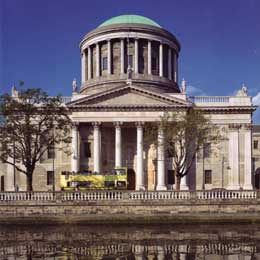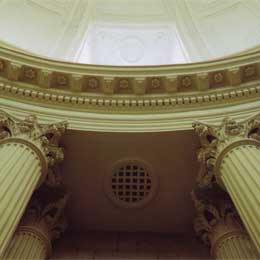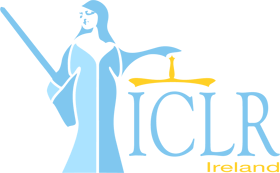History of the Four Courts

Four Courts Building, Dublin
The Four Courts, since the first case heard in them in November 1796, have been at the epicentre of the Irish legal system. Built on the original 13th century site of a Dominican Friary garden which would later become the old King’s Inns, the present Four Courts emerged in the twenty years between 1776 and 1796. The work of architects Thomas Cooley and James Gandon, they were originally designed to bring together the various offices of the Courts and legal records which were, until that time, dispersed in a variety of houses between the river and High Street. In the two hundred years since, the life of the courts has parallelled that of the nation. In 1922, during the Civil War, the buildings suffered bombardment. Later that year the court system became part of the newly-independent state and the building continued to house the successor courts established by or under the 1922 and 1937 Constitutions.
Early History
The 1775 decision to house the country’s legal system under one roof brought to an end the centuries old nomadic nature of the Irish courts. Under English rule in Ireland there had been two legal systems. Within the Pale, with Dublin at its centre, English law prevailed. Justice beyond the Pale was administered under the old Brehon laws. Prior to the 17th century the courts sat in various locations, though mostly in Dublin Castle. The transitory nature of the courts ended in 1608 when they were located in new buildings in the grounds of Christ Church and in the adjoining Christ Church Place. The space proved inadequate, however, and the offices of the courts and the legal records remained dispersed. In 1775 a decision was made to build new premises on the present site.
Architecture

Interior of the Four Courts Building
Work, based on the designs of Thomas Cooley, architect of the Royal Exchange, began in 1776. Cooley’s building concentrated in the area of the west courtyard and was intended to house only the Public Offices and King’s Inns. When Cooley died in 1784, James Gandon, architect of the Customs House, was appointed to add the courts to the plan. Into his completed design he incorporated Cooley’s extant building, adding two quadrangles and a central block. The quadrangles were given to the record and legal offices, the centre to the Four Courts of Chancery, Exchequer, King’s Bench and Common Pleas. At the hub is the Round Hall, 64ft in diameter, with inner and outer domes and a surround of Corinthian columns. The completed courts opened for business on 8th November, 1796. In 1840, land was acquired to the back of Gandon’s central structure and the building which now houses offices of the Law Society of Ireland was added. A new and separate Public Record Office was also erected. Structurally, the hall and domes are largely as Gandon left them. The interior decoration was, however, much richer before the Civil War damage of 1922. Statues of Irish judges and lawyers stood in the niches, the floor was flagged in stone and the dome enriched with the stucco work of sculptor Edward Smyth. Smyth’s five roofline statues which survived have been identified as Moses, Justice, Mercy, Authority and Wisdom. Changes made in repairing the badly-damaged building after 1922 have not greatly altered the aspect of the older building. The Supreme Court has been added and a new Library built.
Legal History
The Four Courts as a term long predates its use as a name for this building. Its origins are medieval and linked to the principal four courts of Exchequer, Common Pleas, King’s Bench and Chancery. The earlier buildings around Christ Church, as well as their predecessors in Dublin Castle, were all in their time known as the Four Courts. The term survived the merger of the courts into one High Court by the Judicature Act of 1877, a watershed in Irish legal history which brought about much needed reform. The 1877 Act created a unified courts system where the rules of equity and of common law could be applied by one court. This effectively brought to an end the system whereby courts sat in banco and meant that the four courts, together with certain other specialist courts, were merged into one High Court with normally a single judge sitting.
Today’s High Court has full and unlimited original jurisdiction, with the power to declare legislation invalid if it does not comply with the Constitution of Ireland. Under the modern Irish legal system the 1937 Constitution, Bunreacht na hÉireann, is the primary source of law. But the Constitution carries over the pre-existing common law and statute law in so far as they are not inconsistent with it. Membership of the European Union brought with it an additional source of law in the form of the Treaty of Rome and the legislation made under it. The Supreme Court consists of the Chief Justice and seven ordinary Judges. The High Court consists of a president and nineteen ordinary Judges. In addition to the Supreme and High Courts these buildings also house the Circuit Court, which is a regional court with limited civil and criminal jurisdiction. Throughout the two hundred years, the Bar of Ireland have practised from the Law Library within the building. A famous institution, the Law Library has effectively served as a headquarters, place of work, library and club of the barristers profession. An equally-famous meeting place has been the Round Hall which during term becomes a hive of activity where numerous counsel and solicitors gather with their clients and endeavour to settle cases before they are called for hearing.
Contact us for further information.
